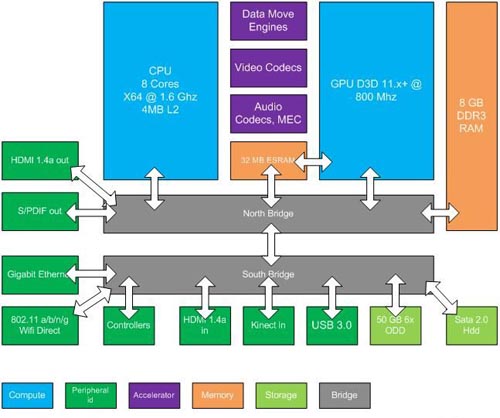
Xbox 720 con Blu-ray: arrivano conferme
Gian Luca Di Felice - 23/01/2013, 11:33
|
||
I colleghi di VGLeaks hanno pubblicato sul loro sito un diagramma dell'architettura hardware della nuova e attesa console di Microsoft Xbox 720 (nome in codice Durango), che reputano assolutamente attendibile. Per ora preferiamo ancora usare il condizionale, in attesa della presentazione ufficiale o di comunicazioni da parte di Microsoft. Secondo il diagramma, la nuova console dovrebbe integrare una CPU 8 core con architettura 64 bit e clock a 1,6 GHz, una GPU compatibile Direct 3D 11.1 cadenzata a 800MHz (entrambe prodotte da AMD), 8GB di RAM DDR3, hard-disk Sata 2.0, porta USB 3.0, connessione Ethernet Gigabit e Wi-Fi "n" con supporto Wi-Fi Direct e uscite audio digitale S/PDIF e audio-video HDMI 1.4. Interessante, infine, notare la presenza di un drive ottico da 50GB con velocità di lettura 6x ed è quindi facile dedurre che tale dicitura nasconda molto più semplicemente l'integrazione di un drive di lettura Blu-ray. Di seguito tutte le caratteristiche tecniche annunciate da VGLeaks: CPU: Fonte: VGLeaks |
Vietata la copia e la distribuzione (anche parziale) senza la previa autorizzazione di AV Raw s.n.c.
Per maggiori informazioni : https://www.avmagazine.it/sito/legale/
Copyright 2005 - 2025 AV Magazine
AV Magazine - registrazione Tribunale di Teramo n. 527 del 22.12.2004
Direttore Responsabile: Emidio Frattaroli
